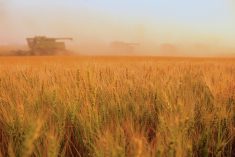CNS Canada — Drought and heat continue to pound Germany’s crops and analysts now expect the lightest harvest in 24 years, the association of German farm co-operatives DRV said in an Aug. 8 harvest report.
The harvest for all grains is expected to decline to about 36.3 million tonnes, a 20.3 per cent fall and the smallest grain harvest since 1994, the association reported.
Winter wheat production will decline 19.9 per cent to 19.2 million, it stated.
All other wheat is expected to fall 18.6 per cent to 19.9 million tonnes.
Read Also

U.S. livestock: Feeder cattle hit contract highs on tight supply
Chicago | Reuters – All Chicago Mercantile Exchange feeder cattle futures and most live cattle futures hit contract highs on…
The German grain harvest overall is expected to fall below domestic requirements, the association said, which suggests the country will need to import this year, contrary to its normal market position as a net grain exporter.
Germany is one of several European Union countries suffering from extensive drought this year.
Wheat prices in the EU climbed to five-year highs last week, as markets become worried about future supply.
Germany is the EU’s second-largest grain producer after France.
Corn has been among the hardest-hit with the German crop expected to fall by 49 per cent to 2.30 million tonnes, the association said.
That will also stress livestock feed because much of the crop is grown for domestic feed purposes. Winter barley, also used mostly for feed, is expected to fall 18.1 per cent to 7.38 million tonnes.
DRV forecast Germany’s winter rapeseed crop will fall to 3.47 million tonnes, a drop 18.6 per cent.
Malting barley, meanwhile, is expected to increase by 14.2 per cent to 2.09 million tonnes due to increased seeded acreage.
















